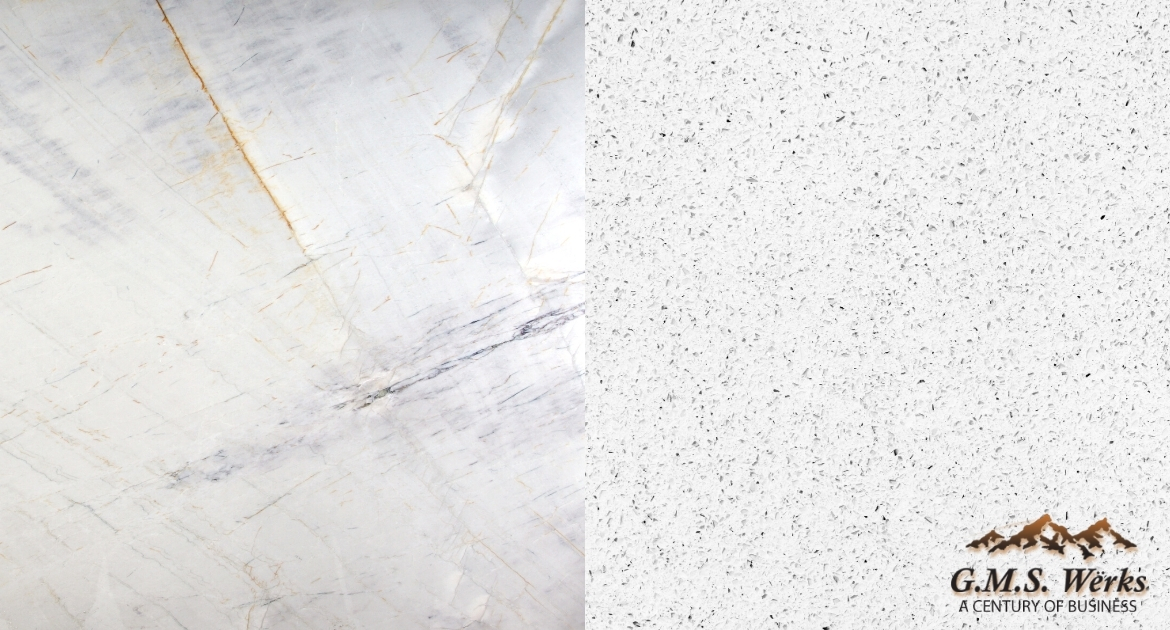-
4225 Florence Blvd
-
Appointments Recommended
Mon - Fri: 8:00am - 4:00pm
-
Schedule Your Appointment:
(402) 451-3400 - Request Quote
Mon - Fri: 8:00am - 4:00pm

In the world of kitchen and bathroom countertops, quartzite and quartz are two popular materials that stand out. While these materials may sound similar in name, they are vastly different, each providing its own unique benefits and differences. Luckily, at GMS Werks, our team are experts when it comes to both quartzite and quartz countertops!
Below, we go over the distinct differences between quartzite and quartz countertops, explaining the benefits of both!
Quartzite is a natural stone that comes completely from nature. This material is formed beneath the earth’s surface when quartz-rich sandstone is altered through high pressure and temperature. It is then extracted and cut into stone slabs.
Quartz is an engineered stone molded and baked into slabs. This material contains about 90 to 94 percent of quartz that is mined from underground.
The main difference between the two materials is that quartzite is 100 percent natural as it only contains naturally occurring components. Quartz, however, is a man-made material that is 90 percent natural, but 10 percent man-made with polymer and other pigments.
When it comes to colors and patterns, quartz has a lot more to offer. The pigments added to quartz can be used to achieve a wide range of colors and can be processed to display uniform patterns across each slab.
Quartzite, on the other hand, usually only comes in white or grey color shades. Quartzite is also limited when it comes to patterns, and it usually resembles granite or marble in terms of inconsistencies from one end of the slab to the other. If a more natural look is what you’re looking for, then quartzite is your answer!
Quartzite is a very durable material that can handle heat very well. It’s so durable that it is known to be harder than granite. However, since it’s natural, there is a slight risk of chipping or denting.
Quartz does not handle heat well, and it can eventually start to melt since it’s manufactured with plastic. However, this also means that quartz is less prone to denting and chipping, as it is more flexible than quartzite.
When it comes to maintenance and making sure your countertops are always looking good, quartz is the easier route. This material is easily cleaned and wiped off with a wet cloth.
Quartzite requires a bit more maintenance, as it must be sealed before use. Homeowners should reseal their quartzite countertops often, at least once a year, to ensure stains do not penetrate through the stone.
Quartzite and quartz countertops are very similar in price, usually costing about $60 to $100 per square foot. However, since quartzite is all-natural, it requires a more complex installation, which in turn may lead to higher costs. Quartz, however, can be modeled to suit basically any application or design, significantly reducing the installation costs!
When searching for new countertops, you will inevitably come across both quartzite and quartz. However, it’s important that you know and understand the differences between the two to make the best decision possible. Hopefully, these quartz and quartzite characteristics will help make your next countertop decision a little bit easier!
At GMS Werks, our team is very knowledgeable about all of the quartzite characteristics as well as many other natural stone materials. To learn more about our services, visit our website or give us a call today!